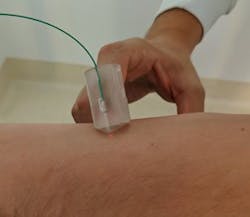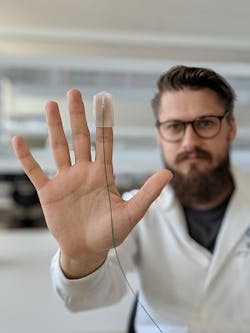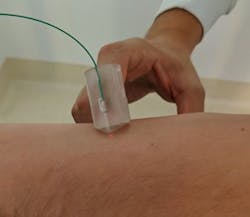Optical fiber fingertip probe could improve breast cancer removal
A team of researchers at the University of Western Australia (UWA; Perth, Western Australia) has developed a wearable thimble-like device that incorporates an optical fiberprobe to enhance the sense of touch by imaging and quantifying the stiffness and elasticity of biological tissue. The device is being developed to improve the surgical removal of breast cancer, with potential use for brain and liver surgery and other types of cancer.
"Our new probe aims to enhance the surgeon's subjective sense of touch through quantified, high-resolution imaging of tissue stiffness," says Rowan W. Sanderson, first author of the paper that describes the work. "This could make it easier to detect and remove all the cancerous tissue during the first breast-conserving surgery, which would reduce the physical and psychological burden and cost that accompanies re-excision."
A new wearable probe enhances the sense of touch by imaging and quantifying the stiffness and elasticity of biological tissue. The device could help improve the surgical removal of breast cancer and other types of cancer. (Image credit: Rowan W. Sanderson, University of Western Australia)
The finger-mounted probe uses a technique called quantitative micro-elastography (QME) to translate the sense of touch into high-resolution images. QME uses measurements from an optical imaging technique called optical coherence tomography (OCT), which generates high-resolution, depth-resolved images of tissue structure by measuring the reflections, or "echoes," of light.
To use the device, the finger-mounted probe is pressed perpendicularly into the tissue while OCT images are recorded. "By preserving the sense of touch, we aim to conserve the existing clinical workflow and increase the likelihood that this technology would be adopted for wider clinical use," Sanderson says.
For accurate elasticity measurements, the researchers developed signal processing methods with custom algorithms to deal with inconsistent motion and pressure during scanning. 3D printing helped them quickly produce prototypes of the probe's outer casing in a simple and cost-effective manner.
"Our finger-mounted probe can accurately detect microscale changes in stiffness, which are indicative of disease," Sanderson says. "The small size makes it ideal for imaging in confined spaces, such as a surgical cavity."
To use the device, the finger-mounted probe is placed perpendicular to the body and pressed on the tissue while OCT images are recorded; the researchers want to incorporate the sensor into a surgical glove that would preserve touch sensitivity. (Image credit: Rowan W. Sanderson, University of Western Australia)
To validate the probe, the researchers began by testing it on silicone phantoms designed to mimic healthy and diseased tissues in the breast. These tests showed that the finger-mounted probe had an accuracy of 87%, which was slightly lower than a conventional benchtop QME system, but still sufficiently high for potential clinical use.
They then used the probe to measure the change in stiffness caused by heating a sample of kangaroo muscle. This experiment showed the muscle sample underwent a sixfold increase in stiffness following the heating process. A preliminary 2D image was obtained by scanning the probe laterally across a silicone phantom containing a stiff inclusion. Although it showed lower accuracy than the experiment performed without scanning, the researchers say that the prospect for imaging by swiping the operator’s finger is very encouraging. "The contrast between sample features was still evident, which indicates that 2D scanning holds a lot of promise going forward," Sanderson says.
The researchers are now working to embed the optical components of the probe into a surgical glove that would preserve the touch sensitivity and dexterity of manual palpation. They are also improving the accuracy of the 2D scanning.
Full details of the work appear in the journal Biomedical Optics Express.


